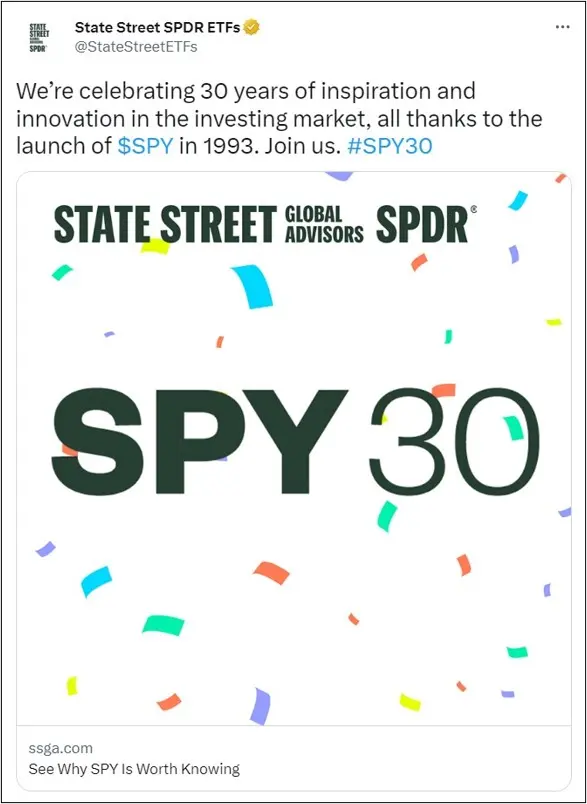
A shout-out to ETF marketing, sales teams at the 30-year mark
The SPDR S&P 500 ETF (SPY) celebrated its 30th anniversary this week, and everybody who’s anybody has weighed in with fascinating reminiscences about how the idea set what had been a complacent mutual fund business on fire. More than the anniversary of a single product, Jan. 22, 1993, was the start of an industry that’s grown from SPY’s original investment of $6.5 million to $6.5 trillion in AUM today.
So impressive. This Vetta Fi post includes a chart that shows, as introduced by Dave Nadig, the “last 10 milliseconds of trading in SPY [on a random day last week]. Millions and millions of dollars changing hands, in hundreds of individual trades before the closing auction strikes. SPY is arguably the most ‘live’ security in the world.” In 2022, according to the Financial Times , the fund’s average daily trading volume was more than three times Apple’s stock.
Congratulations to those responsible for the product innovation, development and delivery of the ETF as a new, improved product wrapper. But with every celebratory post, I keep searching for a mention of marketing. Hey, what about marketing’s role in all this?
In fact, the FT coverage includes a quote from Vanguard’s John Bogle as describing the ETF “as the most successful financial marketing idea so far during the twenty-first century.” Well, that’s something, let’s go with that.
All those involved in marketing and selling the benefits of the new type of fund absolutely deserve their own round of applause. As brilliant as their ideas were, the ETF trailblazers needed marketing and marketing communications enabling Sales’ and media conversations to make things happen. In large part, ETFs’ success story is a credit to marketing and sales’s resourcefulness in educating about creation baskets, authorized participants and even exemptive relief while promoting and selling.
Fund marketing: Backward and in heels
Many years ago a compliment was paid to the dancer Ginger Rogers, frequent partner to Fred Astaire: “Don’t forget that Ginger Rogers did everything Fred did…but she did it backward and in heels.” The same could apply to ETF marketing—those early marketers and sales teams needed to do everything marketing and sales does in other industries, but within the confines of a regulated industry as interpreted by compliance officers who themselves were feeling their way. SPY’s very generous advertising budget, alluded to in the FT article, provided massive visibility. But, most other issuers competed with much, much less.
My awareness of ETFs started about halfway into the product’s life, when I joined Claymore Securities in 2007. Claymore was a top ETF 10 issuer on a list very different from today’s top 10, with Barclays iShares and PowerShares leading the way with wonderfully vibrant marketing. The difference started with the product, of course, and the ability to deliver exposure to slices of markets. But these funds were going to be trading and, in contrast to those long tortured names that most mutual funds bear, ETFs needed names and tickers that would be memorable. My favorites included the Claymore Yield Hog (since renamed) and TAN, the solar ETF.
The race to get out there first and build a lead before a competitor followed with a lookalike product (these were passive ETFs at this point) was exhilarating. Of course, most of the early communications had to be digital. Emails, microsites, explainer videos, whitepaper PDFs, banner advertising, monthly press releases and even tweets on daily or monthly sales figures, a flash mob or two, and swag—everything seemed fresh and flashy. Traditional media was slow on the uptake with product coverage, as I recall. Instead, it was ETFTrends, IndexUniverse and SeekingAlpha that were all over the space. A fund launch was enough to merit an interview on CNBC.
So much has happened since then, not the least of which were the widespread adoption by financial advisors of ETFs for client portfolios, the development of active funds, and the entry of the biggest mutual fund companies, and inevitably, the acquisition of the early innovators.
Here come the challengers
Marketing and sales teams continue to fight the good fight as ETFs likely overtake mutual funds this year.
What’s intriguing on this anniversary is how the competitive field has broadened. Mutual funds and ETFs aren’t the only products competing for retail investor attention and financial advisor support. At 30 years old, the ETF is no longer the upstart and may at some point be defending its position against new products and solutions (e.g., interval funds, custom SMAs/direct indexing) on the horizon.
Do the new contenders have what it takes to change the game as Cerulli and others are forecasting? Investment skill is a prerequisite, of course. And, we know the product development and product management teams, supported by technology teams on these new solutions especially, will do their part.
But then, as with the ETF ramp-up, the heavy lift is coming to you, marketing and sales teams. Our recommendation: Brush off your playbook—but, if the ETF experience is any guide, expect to need to significantly change it up. The newest solutions will require your best thinking and more. Fortunately, marketing and sales has never been better equipped, with technology and data access of our own, to execute on a winning strategy.
Subscribe.
Receive the latest news and insights from Lowe Group.
